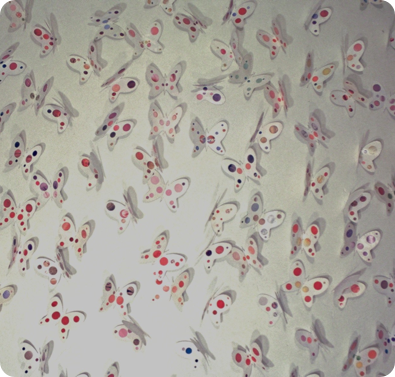synchronicity

At challenging times in my art life, I find it encouraging to remember a moment I experienced early in my career, about seven years ago, when I was doing a residency at the lovely MacDowell Colony in Peterborough, New Hampshire. I was reminded vividly of it during my conversation recently with Angela Carone from KPBS when I told her the story during our chat in preparation for her piece on me on her very cool blog “Culture Lust”:
I was using my time at MacDowell to work simultaneously on two disparate and seemingly unconnected pieces. My work revolved around not only books at the time, but about other forms of print media as well - magazines, in particular - and the two projects I was working on at the time were my Moby Dick book piece, a giant eleven foot text spiral constructed from two copies of the Melville classic, and an installation of white paper butterflies embellished with polka-dots cut from brightly colored images of makeup in fashion and beauty magazines. The two pieces could not have seemed more disconnected to me at the time - Moby Dick being the hyper-masculine tale that it is, and then this girly butterfly piece conjured from memories of being a teenager just beginning to wear makeup and rather over-doing it, gobbing great quantities of color onto my young, unblemished skin. As time- and labor-intensive as the large book pieces are, I tend naturally not to read closely (or at all) the text as I'm working on it, except to make sure I'm on track. One particular day in my studio there, though, the word butterfly just happened to catch my eye as I laid down a line of text from Moby Dick, and I couldn't help but stop and read the passage in which it appeared. It was a part of the chapter entitled 'The Whiteness of the Whale', an eight-or-so page musing on the psychology and symbolism of the color white. Here is what I read:
"And when we consider that other theory of the natural philosophers, that all other earthly hues - every stately or lovely emblazoning - the sweet tinges of sunset skies and woods; yea, and the gilded velvets of butterflies, and the butterfly cheeks of young girls; all these are but subtle deceits, not actually inherent in substances, but only laid on from without; so that all deified Nature absolutely paints like the harlot, whose allurements cover nothing but the charnel-house within; and when we proceed further, and consider that the mystical cosmetic which produces every one of her hues, the great principle of light, for ever remains white or colorless in itself, and if operating without medium upon matter, would touch all objects, even tulips and roses, with its own blank tinge - pondering all this, the palsied universe lies before us a leper...."
I'm not sure if I can even express what a great moment it was for me - not just the unlikely stumbling upon of a mention of butterflies, so incongruously and unexpectedly in the midst of Moby Dick, but that the imagery within the passage was specifically about young girls and employed phrases so specific as 'paints like the harlot' and 'cosmetic' and 'allurements' (my residency there came fresh on the heels of my first solo exhibition, the title of which was 'Allure' after one of the magazines I used in much of the work in the show). The synchronicity of events was (and remains to this day) extraordinarily meaningful to me, a kind of new-age moment in which everything I was doing truly was connected. It made sense of what I do in a way I couldn't at the time and still, when I recall it, gives me great faith in what I do.
Thursday, March 26, 2009
